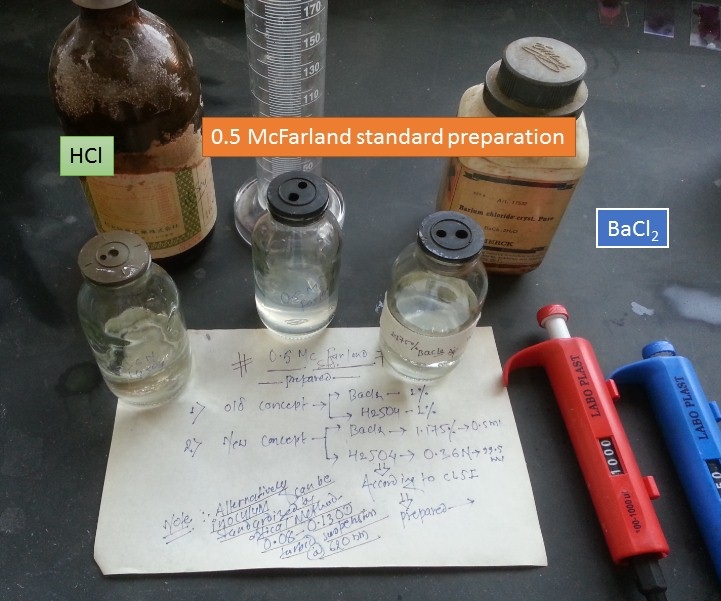McFarland Standard: Introduction, Preparation and Its Application

Introduction of McFarland standard
McFarland Standard uses as the reference in order to adjust the turbidity of the microbial suspension in the tube that helps to ensure that the number of organisms (bacteria, fungi, etc) will be within a given range to standardize microbial testing. The McFarland standard tubes are available in various concentrations ranging from 0.5 to 4 but the most commonly used concentration is 0.5 McFarland standard. It uses for antimicrobial susceptibility testing (AST), anti-fungal susceptibility testing (AFST), and culture media quality testing.
Principle of McFarland standard preparation
Original McFarland Standards are the chemical solution of barium chloride (BaCl2) and sulfuric acid (H2SO4) and reaction between these two chemicals result in the production of a fine precipitate of barium sulfate. (Note: Nowadays McFarland standards are prepared from suspensions of latex particles, which lengthens the shelf life and stability of the suspensions.) First shake well, the turbidity of a McFarland Std. and comparable visually to a bacterial or fungal suspension of known concentration. These McFarland standards are prepared by mixing various volumes of 0.18 M H2SO4(1% w/v) sulfuric acid and 0.048 M barium chloride (1.17% w/v Bacl2H2O)to obtain solutions with specific optical densities. By adjusting the volume of these two chemical reagents, McFarland standards of varying degrees of turbidity can be prepared that represent different microbial densities. For example 0.5 McFarland turbidity standard is equivalent to an optical density comparable to the density of a bacterial suspension with 1.5 x 10^8 colony forming units (CFU/ml).
Requirements for McFarland Standard Preparation
- Concentrated sulfuric acid
- Anhydrous barium chloride
- Micropipettes and tips
- Measuring cylinder
- Distilled water
- Test tubes
- Spectrophotometer
- Aluminum foils
- Amber-colored bottles
O.5 McFarland Standard Preparation
- Prepare a 1.17% w/v solution of anhydrous barium chloride and 1% solution of sulfuric acid.
- Add 0.5 ml of barium chloride solution to 99.5 ml of a solution of sulfuric acid with constant stirring.
- Mix McFarland standard thoroughly to ensure that it is evenly suspended.
- Using matched cuvettes with a 1 cm light path and water as a blank standard, measure the absorbance in a spectrophotometer at a wavelength of 625 nm.
- The acceptable range for the turbidity standard is 0.08-0.13. Distribute the standard into screw-cap tubes of the same size and volume as those use to prepare the test inoculum. Seal the tubes tightly to prevent loss by evaporation. Store it and protect it from light at room temperature. Agitate the turbidity standard vigorously on a vortex mixer before use. Standards may be stored for up to 6 months, after which they should be discarded.
Application of McFarland Standard
- 0.5 McFarland standard is used in the antimicrobial susceptibility testing (AST) procedure where the bacterial suspension is compared to this McFarland Standard before swabbing on Muller-Hinton agar (MHA).
- It is also used for antifungal susceptibility testing (AFST) procedure where the fungal suspension is compared to this McFarland Standard prior to swab on modified Muller-Hinton agar (MHA).
- It is also supportive for quality control to check and adjust the densities of microbial suspension which can be used for identification and susceptibility procedure.
Keynotes
- When using commercially available the latex standard, the tubes for the suspension should be the same diameter as the McFarland Latex Standard tube.
- The tubes should be sealed tightly to prevent loss by evaporation and stored protected from light at room temperature otherwise the turbidity measurement can be affected.
- According to the new guideline, 1 % barium chloride is replaced by 1.17%barium chloride.
Bibliography
- Clinical Microbiology Procedure Handbook, Chief in editor H.D. Isenberg, Albert Einstein College of Medicine, New York, Publisher ASM (American Society for Microbiology), Washington DC.
- https://www.biodiamed.gr/wp-content/uploads/2017/0 /Manual_on_Antimicrobial_Susceptibility_Testing.pdf
- https://en.wikipedia.org/wiki/McFarland_standards
- http://himedialabs.com/TD/M1825.pdf
